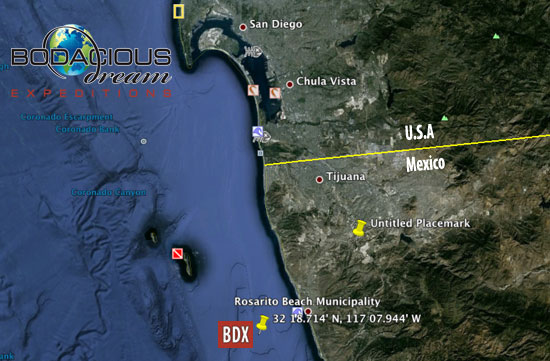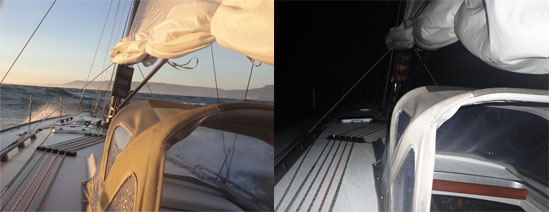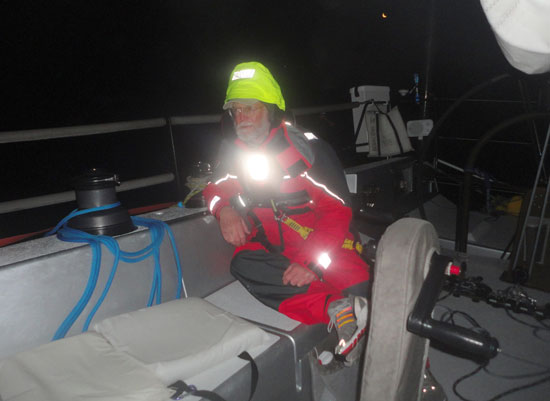The heavy weather of last night subsided this morning and we got in a pretty pleasant day of sailing and making miles northward towards San Diego. “Heavy weather” is a sailor’s way of describing windy and wavy conditions. While the conditions weren’t actually stormy, we did spend a lot of time sailing in 25 to 30 knots of winds with ocean swells running as high as 3 meters (or 10 feet) … throwing thick spray into the air and water across the decks.
As we get closer to San Diego, excitement builds among the crew in anticipation of the end of the passage. The Bo IV crew has been such a blast to sail with – right from the very beginning … but now, as we are approaching the end, we are all doing a lot of math trying to outguess each other as to how many miles we averaged over the last five hours, or what our average speed has been for the day, or what’s been our best distance made in 24 hours and of course, how many hours left until we finish. These are all fun things sailors like to do with numbers … that also underscore the need for them to have good math skills … especially if you are ever going to win any of these guessing games with your fellow crew members!
(So, have you figured out the difference between a knot and a mile per hour? That’s one of the bonus questions on our Explorer Guide for Math, if you want to check that out.)
QUESTIONS: Alongside questions of math, we have also had quite a few questions sent to us, that center on what goes on here, onboard a ship like Bodacious IV over the course of a near weeklong voyage.
For instance, people ask “How do we sleep?” “What we do at night?” “Do we stop somewhere?” “What do we eat?” “How do we stay warm?” Well, to each of those questions, there are various answers. So, let me respond to some of them.
SLEEP: Typically, we sail all through the night without stopping. To do this, we break the night into two watches with each watch lasting three hours. After three hours, a new watch comes on and the old watch goes off to sleep for three hours. We sleep in what we call bunks or berths. These are narrow beds below decks and often at different levels, depending on the design of the boat. They are narrow, so that you don’t get tossed around in heavy weather conditions like we had the last few nights. This system works well for keeping people rested and alert when you are sailing over a longer period of days. Then there are other trips where you might stop every other night in a harbor, and so pass the time more leisurely. But even in those situations, there would still be a watch system to ensure that someone at all times is in charge of the boat and its safe operation. (You can see a few bunks in the photo below.)

Jonathan gears up for foul weather
FOOD/HUNGER: Eating is determined by a number of factors – the most important of which is having food available when you are hungry. But sometimes we have to wait until both crews are ready to eat, so that we can eat simultaneous to our changing watch. We eat primarily for energy, so depending on the level of work being called for, or how hot or cold the weather is, this can change what we eat and how often. When the weather is particularly rough, we often are only able to prepare sandwiches or snack foods. We steer clear of junk food as healthier whole grain breads, meats, fruits and vegetables give us more honest nutrition boosts and just a better and more energetic overall feeling. There is a good deal of math involved here too, as we calculate the energy, the food, the people and what their needs are, as each crew member has different dietary and calorie demands.
FOOD/ TEMPERTURE: Temperature also has a big impact on our diets. When it’s cold, people need to burn extra calories to stay warm … some people of course more than others. As we had heavy dew at night and temperatures down in the 40s, it wasn’t easy to stay warm, dry and alert when your body is trying so hard to find calories to burn. So you eat more when it’s cold out, so your body can keep burning calories and staying warm doing so. Can you see how important eating properly is and how math here too plays a role in the proper food fueling of a chip’s crew? And we haven’t even talked about cooking temperatures and times, and the math involved with doing all that.
To learn more about onboard nutrition, the video below is of an interview I recorded back in Cabo San Lucas with Chef and Master Provisioner Pierce Johnson (and noted nautical gourmand Jonathan Pond.)
Onboard Nutrition w/ Pierce and Jonathan
STAYING DRY & WARM: We also wear special clothes to help keep us dry and warm. Our base layers absorb the moisture from our body so that our skin feels less damp and wet. These materials are often a type of polyester mix of fabrics that have what are called “wicking” characteristics … meaning that they capture the moisture that evaporates from our bodies through sweat and transfers them to the outer layer of the cloth thus pulling moisture away from our bodies into an outer layer where it can evaporate. On top of those base layers, we wear fleeces and on top of those, our foul weather gear. In the old days, they used to just take cotton coats and soak them in wax or oil, so they would repel water when the waves and rain splashed on you.
Modern technology has developed a range of materials that have such small holes in them that even the most microscopic part of water (when it’s in a liquid form like rain or ocean water) can’t penetrate through the holes. At the same time though, when moisture is in an evaporated (vapor) form, like the steam from a teapot or like your warm breath in icy air … that no longer liquid moisture can flow out through the holes. Water can’t get in, but vapor can get out! Pretty cool – or warm – depending on how you look at it. So, with these special clothes, we get the help we need in order to keep ourselves warm and dry in windy and wavy conditions – just like we’ve experienced the last couple of days.
SAFETY: In addition to the foul weather gear, every crew member also wears what are called Personal Flotation Device (or PFDs.) These are automatically inflating life preservers that you wear like a jacket and that have built into then a harness and tether. We clip ourselves to the tether which runs the length of the boat, and prevents us from falling off the boat in rough conditions. Concerns for safety are obviously a very important part of our daily routine on the water. Respect for the power of the ocean must always be foremost in any good sailor’s mind. (In the photo below, Tim and Jonathan model the latest in PFD and tethering fashion.)

Tim and Jonathan in their safety gear
HEADING FOR HOME: We’ll be drafting more detailed summaries not long after arriving in San Diego … but a few words before we land. Knowing what an incredible area this is for whales, we really hoped we’d have seen some whales here the last couple of days, but we haven’t. I think it may well be that they don’t like the heavy weather any more than we do … and so stay longer in the calmer climes below the surface. We did have a lovely visit today from a seagull though. He flew right up behind me and landed on the corner of the boat, just to my left. He traveled with us for a couple of hours before heading off to who knows where. We always feel these moments are special when nature comes to visit us instead of us coming to visit it. Here’s a short video of that encounter captured by Heather.
A Seagull’s Visit
As to the bigger wild life, we never say never though here in the Bodacious Dreamtime; so we will continue to keep an eye out for more whales, dolphins and other wildlife on this last part of our trip.
Again … thanks for following along.
– Dave R., Tim, Heather, Jonathon and Dave H.
 Time: 05:00 PST
Time: 05:00 PST
Coordinates: 32 18.714’ N 117 07.944’ W
Boat Speed: 6.8 knots
Course: 323 degrees


